The 42 millisecond radio pulsars in 47 Tucanae
Below: |
| a) News (updated 2024 October) |
| b) Summary of results (based on Duncan Lorimer's presentation in Crete) |
| c) Plots and data on the 47 Tuc MSPs |
Related sites: |
| - Press release on the discovery of ionized gas in 47 Tuc. |
| - Press release on the discovery of the magnetic field of 47 Tuc. |
| - 3-D animation of the positions of the pulsars in the cluster as inferred from the gas density. |
| - The sounds of the 47 Tuc pulsars (from the Pulsar Sounds page): |
| - For a list of spin periods and orbital characteristics of the millisecond pulsars in 47 Tucanae, have a look at the list of pulsars in globular clusters |
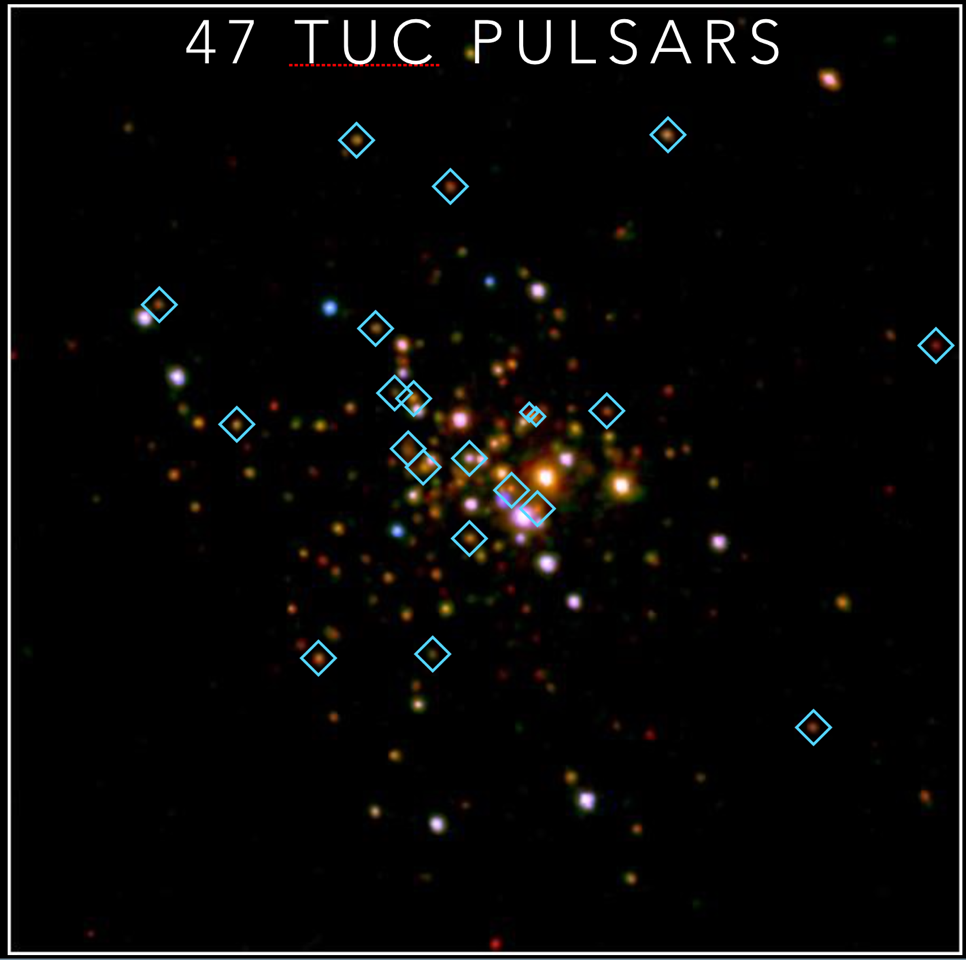
The pulsars in an X-ray map of 47 Tuc. Credit: Craig O. Heinke.
News
Latest papers on 47 Tuc pulsars and their companions:- Rivera-Sandoval et al. 2015
- Cadelano et al. 2015
- Pan et al. 2016
- Ridolfi et al. 2016
- Freire et al. 2017
- Bhattacharya et al. 2017
- Freire & Ridolfi 2018
- Abbate et al. 2018
- Abbate et al. 2020
- Hebbar et al. 2021
- Ridolfi, Gautam et al. 2021
- Abbate et al. 2022
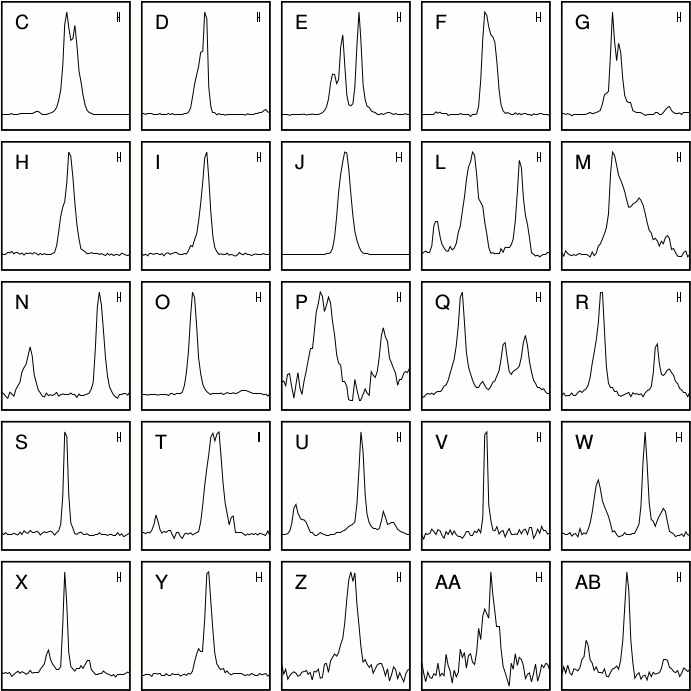
Fig. 1: Pulse profiles for 25 pulsars in 47 Tuc at 20 cm.
The horizontal errorbars show the time resolution of the data.
From the Ph.D. Thesis of Alessandro Ridolfi.
- 47 Tuc X has a spin period of 4.771 ms and is in a binary system with an orbital period of 10.92 days and a minimum companion mass of 0.36 solar masses (henceforth M☉. This value was calculated assuming a pulsar mass of 1.4 M☉). This orbital period and companion mass are by far the largest of any binary pulsar in 47 Tuc. This binary system is located 3.8 arcminutes from the cluster center, more than 3 times more distant than the next most distant pulsar, 47 Tuc C. Its orbital eccentricity is, surprisingly, smaller than 10−6 (The discovery was described by Freire et al. 2017, the orbit and timing solution were presented by Ridolfi et al. 2016).
- 47 Tuc Y has a spin period of 2.197 ms, an orbital period of about 12.52 hours and a minimum companion mass of 0.138 M☉. Its orbital eccentricity is very small as well (see Freire et al. 2017).
- 47 Tuc Z has a spin period of 4.554 ms and is isolated. It was discovered by H. Knight and M. Bailes (see H. Knight's Ph.D. Thesis), its timing solution has derived by Freire et al. 2017.
- 47 Tuc aa and ab are two isolated pulsars discovered by Pan et al. (2016). 47 Tuc aa was thought to have a spin period of 1.845 ms, it has since been found to have a spin period that is twice that (3.69076 ms). It has the highest DM of any pulsar in the cluster (24.94). Its timing solution was determined by Freire & Ridolfi (2018), using a new a new algorithm for automatic determination of timing solutions, known as dracula. 47 Tuc ab has a spin period of 3.70 ms. Its timing solution was determined by Pan et al. (2016) and updated by Freire et al. (2017).
- 47 Tuc ac and ad were found in 2020 with the MeerKAT telescope, as part of the MeerTIME/TRAPUM globular cluster surveys. They have spin periods of 2.74 and 3.74 ms respectively. 47 Tuc ac is part of a ``black widow system'' and 47 Tuc ad is part of a ``redback'' system. They don't have coherent timing solutions yet. For details, see Ridolfi, Gautam et al. 2021.
- 47 Tuc ae to as have been found with the MeerKAT telescope since 2022, as part of the TRAPUM globular cluster survey. They have spin periods between 1.87 and 13.02 ms. Of these 15 pulsars, three (aj, ao and ap) are isolated, all others are in binaries.
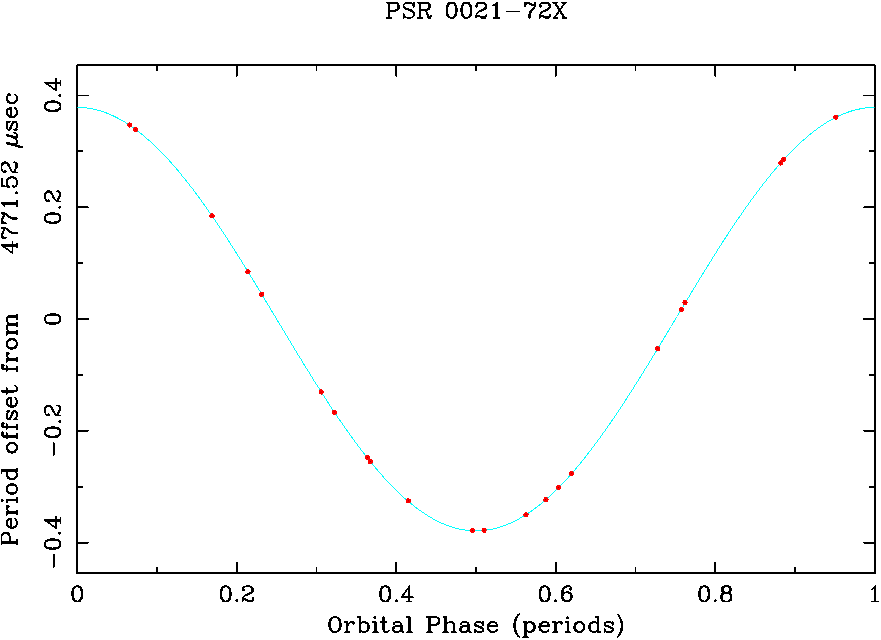
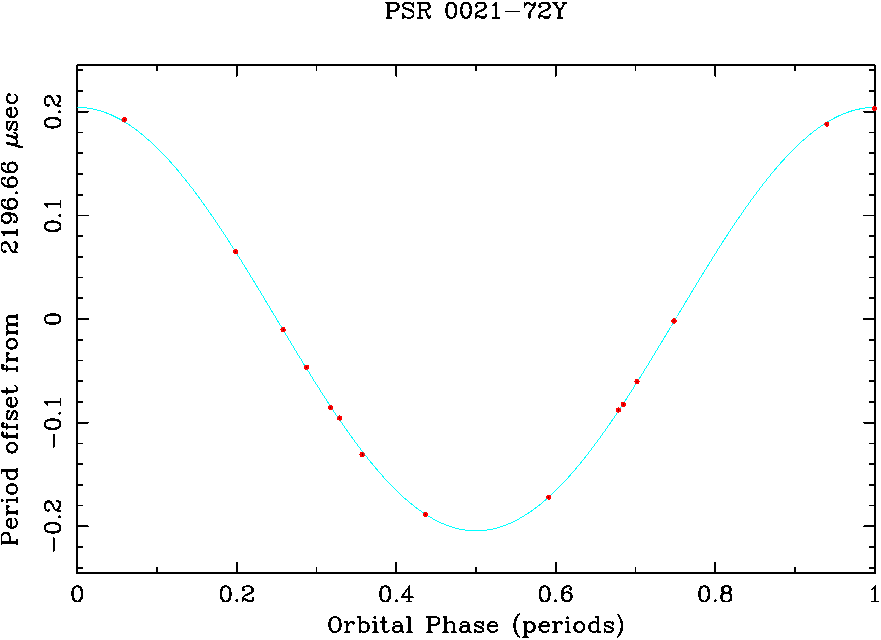
Fig. 2: Red dots: spin periods of 47 Tuc X and Y measured at the
barycentre of the Solar System, as a function of the orbital phase of
the two systems. Blue lines: models for the expected Doppler
shifts caused by their orbital motion.
Knowing the timing solution of a pulsar allows its precise location. All pulsars in 47 Tuc with timing solutions but one (47 Tuc X) are located within 1.2 arcminutes of the core. This is not a selection effect: the Parkes 20 cm beam has a half-power radius of 7.5 arcminutes. This is a real effect caused by mass segregation.
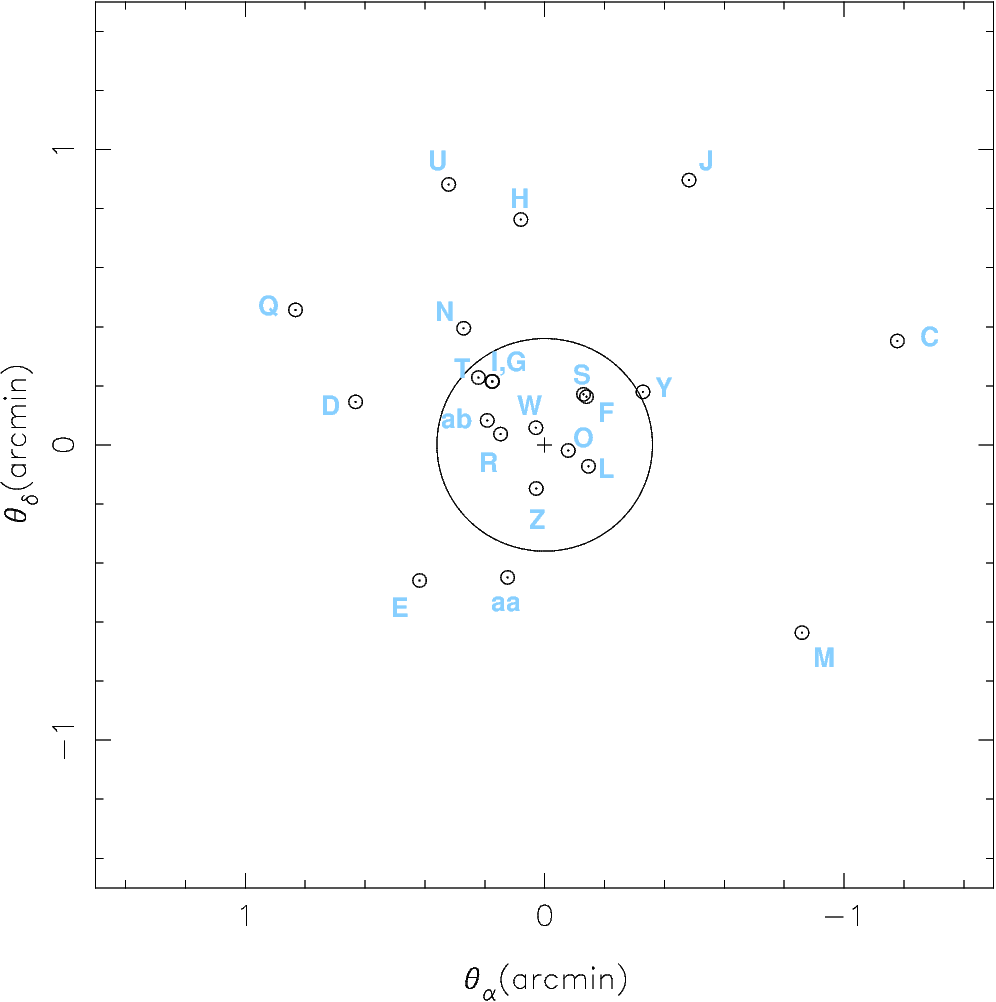
Fig. 3: Top: Angular offsets in right ascension (θα) and declination
(θδ) relative to the center of the globular cluster
NGC 104 (47 Tucanae) of 22 of its 25 known pulsars. The 23rd pulsar with a
known timing solution, 47 Tuc X, is farther to the North, at about 3.8 arcminutes
from the center of the cluster. The circle indicates the limit of the cluster's core.
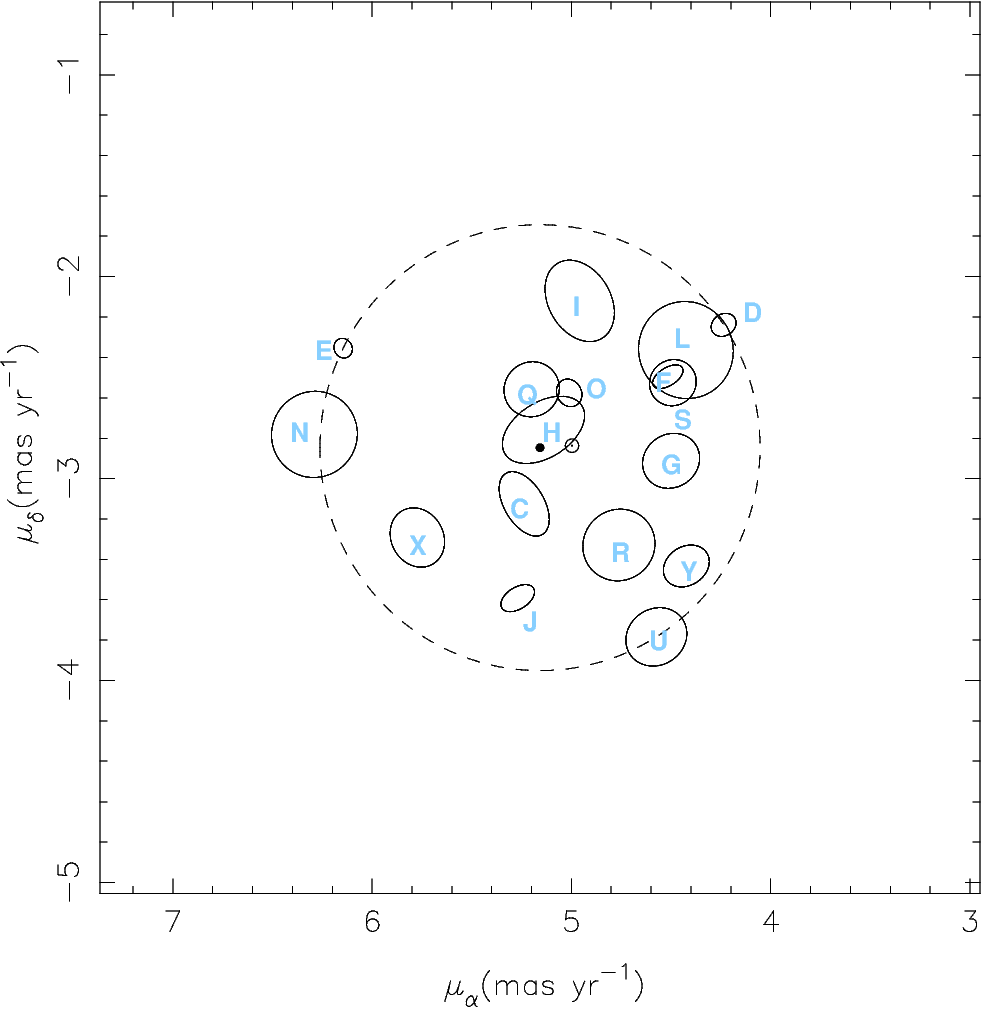
Fig. 4: Proper motions of the pulsars in 47 Tuc. The average of the motions is
given by the Sun symbol; this is an estimate of the motion of the cluster as a whole.
The minimum velocity envelope of all measured
proper motions (about 24.5 km/s) is centered
on the solid dot (another estimate of the cluster motion)
and has an outer radius given by the dashed circle.
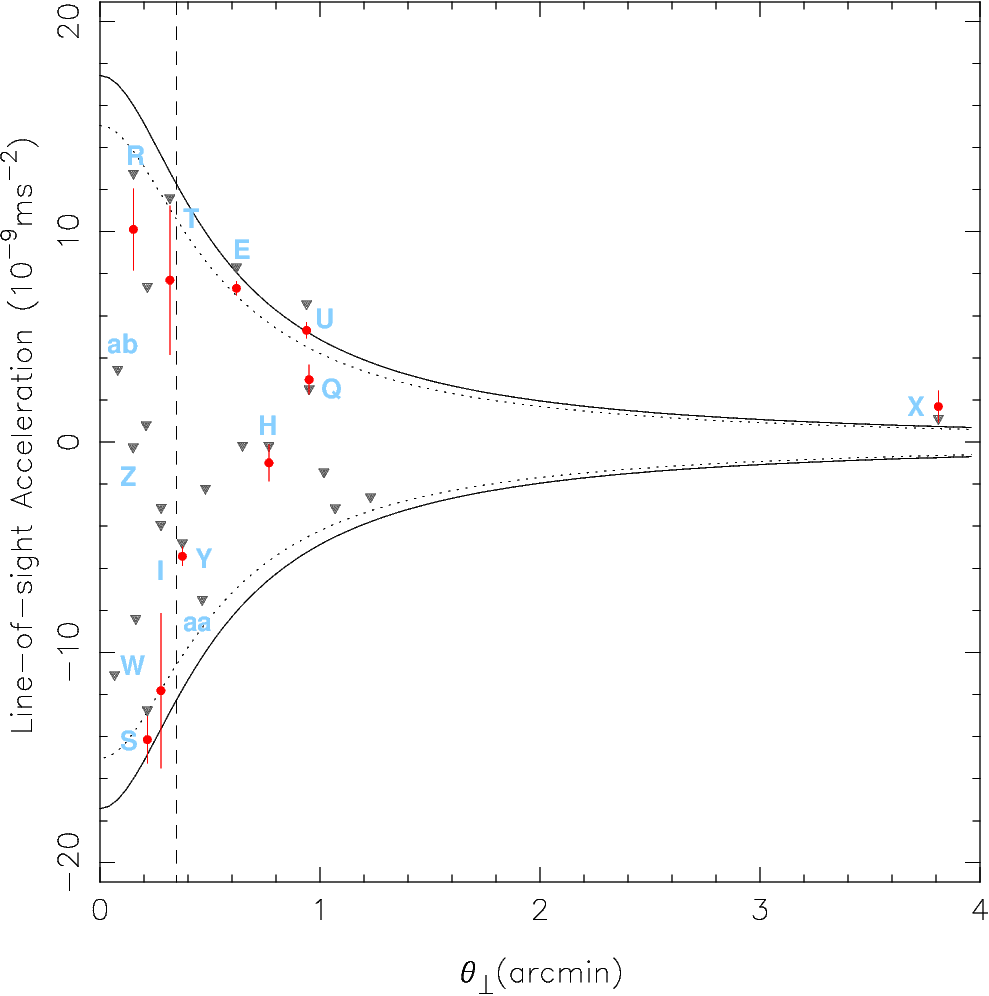
Fig. 5: Accelerations for the pulsars in 47 Tuc as a function
of their angular separation from the center of the cluster. The triangles indicate upper
limits on the acceleration based on the spin period derivative. The red dots with errorbars
indicate measurements of this acceleration based on orbital period derivatives.
A simple analytical cluster model with distance = 4.69 kpc (which predicts maximum and minimum line of sight
accelerations displayed by the black solide lines) can account for all accelerations
and upper limits on the accelerations. If we use a smaller distance
(d = 4.15 kpc, dotted lines) this is no longer true.
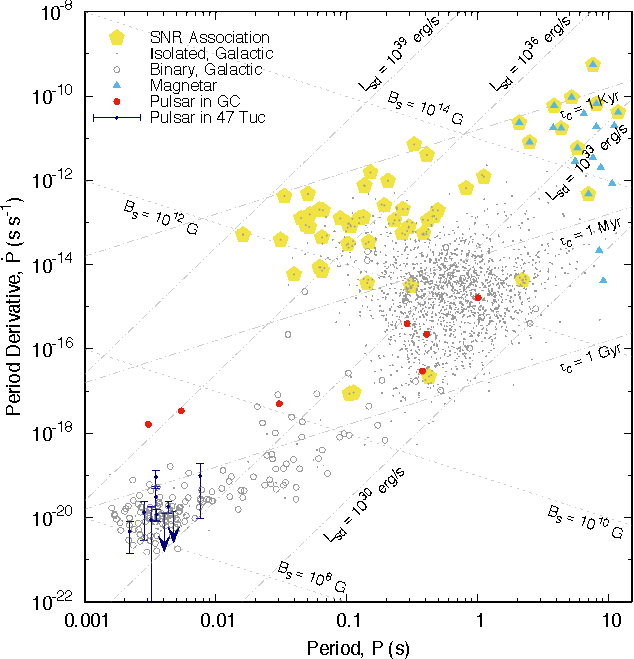
Fig. 6: Positions of 10 47 Tuc MSPs (blue error bars) in the P-Pdot diagram.
Unlike the few GC pulsars with previously known P-dots
(red dots), the 47 Tuc MSPs look like the normal
MSPs found in the Galactic disk.
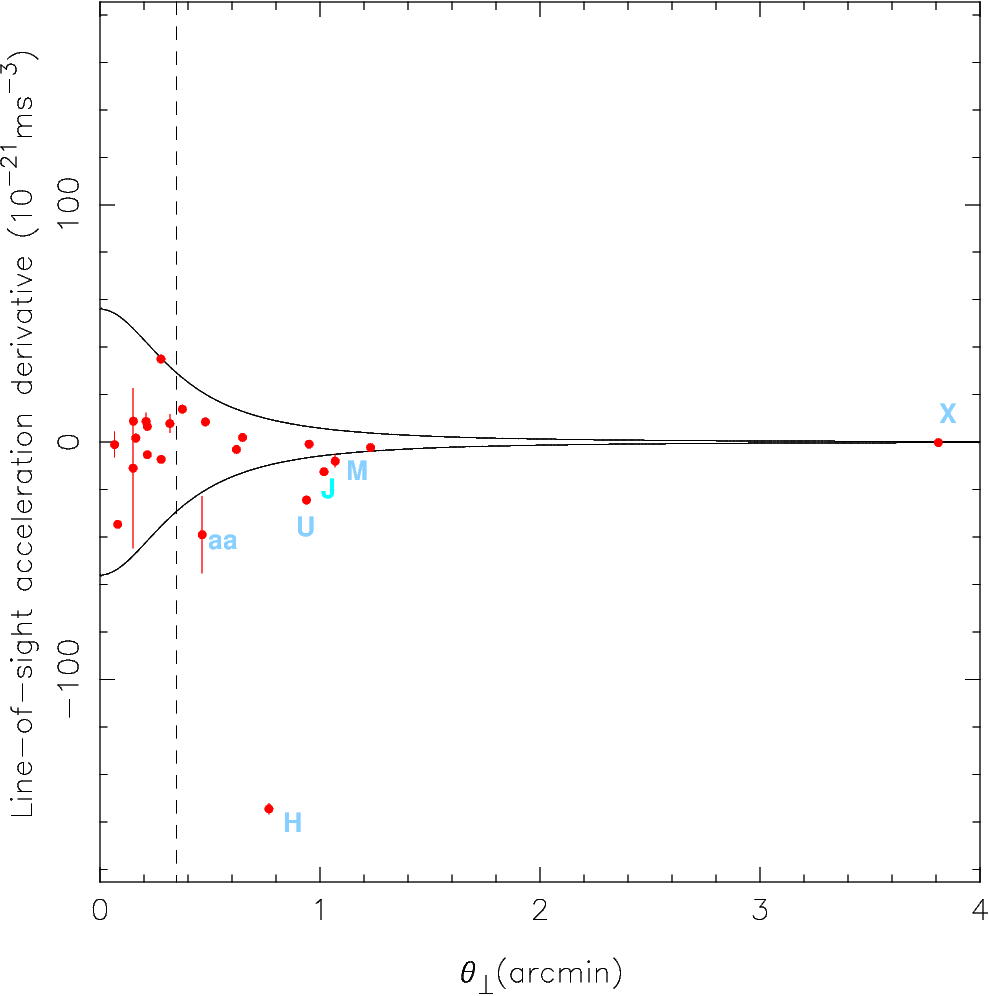
Fig. 7: Jerks for the pulsars in 47 Tuc as a function
of the angular separation from the center of the cluster. The red dots with errorbars
indicate measurements of the jerks based on the second spin frequency derivatives.
Our simple analytical cluster model (which predicts maximum and minimum jerks
displayed by the black solide lines) can account for all observed jerks
except those of 47 Tuc H, U and J.
The white dwarf companions of one of the new pulsars, 47 Tuc Y, and of three previously known pulsars, 47 Tuc Q, S and T, have now been identified at optical wavelengths (see the papers by Rivera-Sandoval et al. 2015 and Cadelano et al. 2015), in addition to the previously known (and relatively bright) companions of 47 Tuc U and W.
Summary of results before 2003:
Millisecond Radio Pulsars in 47 Tucanae
D. R. Lorimer, F. Camilo, P. Freire, M. Kramer, A. G. Lyne, R. N. Manchester & N. D'Amico(note: the article below is now seriously out of date, it was written in 2003, but many of the results are still valid)
The globular cluster 47 Tucanae (hereafter 47 Tuc) contains the second highest number of radio pulsars currently known in any cluster, and about a third of the total number of known cluster pulsars. Early searches at 50 and 70-cm wavelengths using the Parkes telescope discovered the first 11 millisecond pulsars in 47 Tuc by the mid 1990s (Manchester et al. 1990; Manchester et al. 1991; Robinson et al. 1995). Four of the pulsars had binary companions with a median orbital period of 30 hr. Significant modulation of the pulsar signals by interstellar scintillation meant that most pulsars were not detected regularly at these wavelengths; consequently, timing solutions were only possible for two pulsars.
Interest in 47 Tuc was renewed in the late 1990s following the installation of the sensitive 20-cm Parkes multibeam receiver. Using the central beam of this system, a further nine pulsars (all members of binary systems) were discovered by Camilo et al. (2000). The high incidence of binary systems was largely a result of the use of acceleration search techniques in this survey which permitted the detection of short orbital period systems. In addition to better sensitivity, regular observations with the 20-cm system provided more frequent detections of the pulsars. This allowed timing solutions for 16 pulsars to date (Freire et al. 2001a; 2003). Since 1999, data have been acquired using a high-resolution (512 × 0.5 MHz) filterbank which has resulted in a threefold increase in time resolution (Freire et al. 2003). Searches of these data are on-going, with recent (so far unpublished) discoveries of 4.771 and 2.196 ms binary pulsars. Currently the total number of millisecond pulsars known in 47 Tuc stands at 22.
Profiles, Luminosities and Spin Periods
The current sample of 22 millisecond pulsars in 47 Tuc display similar emission properties to their counterparts in the Galactic disk. In their compilation of pulse profiles, Camilo et al. (2000) noticed a similar number of components and incidence of interpulses to the sample of disk millisecond pulsars studied by Kramer et al. (1998). A large sample of pulsars at a common distance means that the flux density distribution is a direct measure of the luminosity distribution. Freire (2000) found that the form of the 1400-MHz luminosity function over the interval 1-10 mJy kpc2 is a power law with a slope of −1, similar to that found for the pulsars in M15 (Anderson 1992), and the population of normal and millisecond pulsars in the Galactic disk (e.g. Lyne et al. 1998). Assuming a spectral index of −2, the observed 1400-MHz luminosities scale roughly to a 400-MHz luminosity interval of 10-100 mJy kpc2. Based on the detection of ~20 pulsars in 47 Tuc, the population of objects with 400-MHz luminosities above 1 mJy kpc2 beamed towards us is of order 200 Camilo et al. (2000).The spin periods of all 22 pulsars lie in the range 2-8 ms. The absence of long-period pulsars is a real effect. Particularly striking is the dearth of pulsars in the 1-2 ms bin compared to 21 objects currently known between 2 and 5 ms. Whether this dropoff at 500 Hz is a real effect (Bildsten, these proceedings) or due to observational selection is currently a matter for debate. The theoretical period sensitivity curve shown in Fig.1a suggests that the 1-2 ms pulsars should be almost as easy to detect as the 2-8 ms pulsars. We are currently searching the high-resolution data to place much more stringent limits on the pulsar population with periods below 2 ms than the Camilo et al. search.
Binary Pulsars
The current population of binary pulsars in 47 Tuc bifurcates into two main groups: those with orbital periods of order 0.4-2.3 days and companion masses ~0.2 M☉ and the so-called very low-mass binary systems which are characterized by shorter orbital periods (1.5-5.5 hr) and lighter companions (~0.02 M☉). Five binaries (J, O, R, V and W) are eclipsed for some portion of the orbit by their companion stars. Of these, J, O and R belong to the very-low-mass group.The acceleration searches employed by Camilo et al. revealed a much higher incidence of binary systems in 47 Tuc than the earlier searches. Currently, 15 of the 22 pulsars (68%) are in binary systems and the median orbital period is 5 hours. The shortest orbital period found so far is the 95-min binary pulsar 47 Tuc R. This is the shortest orbital period currently known for any radio pulsar binary. Could this system and the 11-min orbit of the X-ray source in NGC 6624 (Stella, White & Priedhorsky1987) be the tip of the iceberg of a large population of short-period binaries in globular clusters? Population syntheses (Rasio, Pfahl & Rappaport 2000) suggest that this may be the case. Sensitive accleration searches are currently underway to probe this proposed population.
Astrometry
Phase-coherent timing solutions currently exist for 16 of the 22 pulsars (Freire et al. 2003) resulting in milliarcsecond positional determinations (or better in some cases). All 16 pulsars lie within 1.2 arcmin (4 core radii) of the cluster center, in spite of the fact that the radius of the 20-cm Parkes beam is 7 arcmin. This concentration suggests that the pulsars have reached thermal equilibrium (Rasio 2000; Freire et al. 2001a). The accurate positions have enabled CHANDRA and HST follow-up work on some of the pulsars (Heinke et al.). The pulsar radial distribution is consistent with that of the soft X-ray sources.Proper motions have now been measured for 11 of the pulsars and upper limits for 5 others (Freire et al. 2003). Currently the weighted mean of the pulsar proper motions is consistent with the optical proper motion (Odenkirchen et al. 1997) at the 3 sigma level. Pulsar proper motions are currently dominated by the bulk motion of 47 Tuc. In the future, as the time baseline extends, it should be possible to measure pulsar motions with respect to the cluster center.
Probing the mass and gas in 47 Tuc
Currently, 10 out of the 16 pulsars with phase-coherent timing solutions are observed to have negative period derivatives (dP/dt < 0 ). Rather than being intrinsic to the pulsars, the most natural explanation for this apparent spin-up is the line-of-sight accelerations as the pulsars move within the gravitational potential of the cluster. Freire et al. (2001a) demonstrated that a simple King model potential was consistent with the observed period derivatives. Neglecting Galactic and proper motion terms we have(dP/dt / P)obs = (al/c) + (dP/dt / P)int
where al is the line-of-sight acceleration. It follows that all pulsars with (dP/dt / P)obs < 0 are on the ``far side'' of the cluster. Assuming the intrinsic period derivative (dP/dt / P)obs > 0 implies |al/c| > |dP/dt / P|obs. A lower bound on al can be used to place a lower bound on the surface mass density of the matter interior to the pulsar, S (see e.g. Phinney 1992). The most stringent constraint so far is for 47 Tuc S (Freire et al. 2003) which lies, in projection, about 12'' from the center of the cluster. For this pulsar al > 1.3 × 10−6 cm s−2, which implies
S > 8.4 × 104 M☉ pc−2
Perhaps the most striking result from the radio pulsars in 47 Tuc to date is the combination of the above acceleration data with high-precision measurements of the pulsar dispersion measures which has permitted the detection of ionized gas within the cluster (Freire et al. 2001b). This is shown in Fig. 1b where those pulsars with higher dispersion measure are all on the far side of the cluster - (dP/dt / P)obs > 0 . Under the assumption of a King model potential, and an intrinsic dP/dt for each pulsar similar to those known in the Galactic disk, Freire et al. (2001b) calculated the radial distance along the line of sight for each pulsar and, as shown in Fig. 1c, showed that this strongly correlates with dispersion measure, implying a mean free electron density of (0.067 ± 0.015) cm−3. Within the central region of 47 Tuc occupied by these pulsars, this corresponds to a total gas content of ~0.1 M☉. This value is much less than the ~100 M☉ expected to accumulate within the cluster core over 107-8 yr (Roberts 1996).

We thank numerous observers who have helped collect 47 Tuc data at Parkes over the years. DRL is a University Research Fellow funded by the Royal Society. FC is supported by NASA grant NAG 5-9950.
Plots and data on the 47 Tuc MSPs
First, here is list of Parkes observations of 47 Tucanae from which these results were derived.Below, we present (under ``parameter files'') the timing solutions for the millisecond pulsars in 47 Tucanae. We also present the residuals plots for the millisecond pulsars obtained with the latest parameter files; these were not presented in the recent timing papers for lack of space.
In these plots, the 430-MHz and 660-MHz residuals are coloured red, the low-resolution L-band residuals (centered at 1374 MHz) are coloured magenta and the high-resolution L-band residuals (centered at 1390 MHz) are mostly coloured blue (sometimes we extract multiple frequency TOAs from those observations).
| Pulsar |
|
|
|
|
|
|
|
aa: Freire & Ridolfi 2018, others: Freire et al. 2017) |
|
|
|
|
| J0023−7204C |
|
|
|
|
|
| J0024−7204D |
|
|
|
|
|
| J0024−7205E |
|
|
|
|
|
| J0024−7204F |
|
|
|
|
|
| J0024−7204G |
|
|
|
|
|
| J0024−7204H |
|
|
|
|
|
| J0024−7204I |
|
|
|
|
|
| J0023−7203J |
|
|
|
|
|
| J0024−7204L |
|
|
|
|
|
| J0023−7205M |
|
|
|
|
|
| J0024−7204N |
|
|
|
|
|
| J0024−7204O |
|
|
|
|
|
| P - No sol. yet, good orbit | |||||
| J0024−7204Q |
|
|
|
|
|
| J0024−7204R |
|
|
|
|
|
| J0024−7204S |
|
|
|
|
|
| J0024−7204T |
|
|
|
|
|
| J0024−7203U |
|
|
|
|
|
| V - No sol. yet, good orbit | |||||
| J0024−7204W |
|
|
|
|
|
| J0024−7201X |
|
|
|
|
|
| J0024−7204Y |
|
|
|
|
|
| J0024−7205Z |
|
|
|
|
|
| J0024−7205aa |
|
|
|
|
|
| J0024−7204ab |
|
|
|
|
|
| ac | |||||
| ad | |||||
| ae | |||||
| af | |||||
| ag | |||||
| ah | |||||
| ait | |||||
| aj | |||||
| ak | |||||
| al | |||||
| am | |||||
| an | |||||
| ao | |||||
| ap | |||||
| aq | |||||
| ar | |||||
| as |
Imprint / Privacy policy / Back to Paulo's main page.